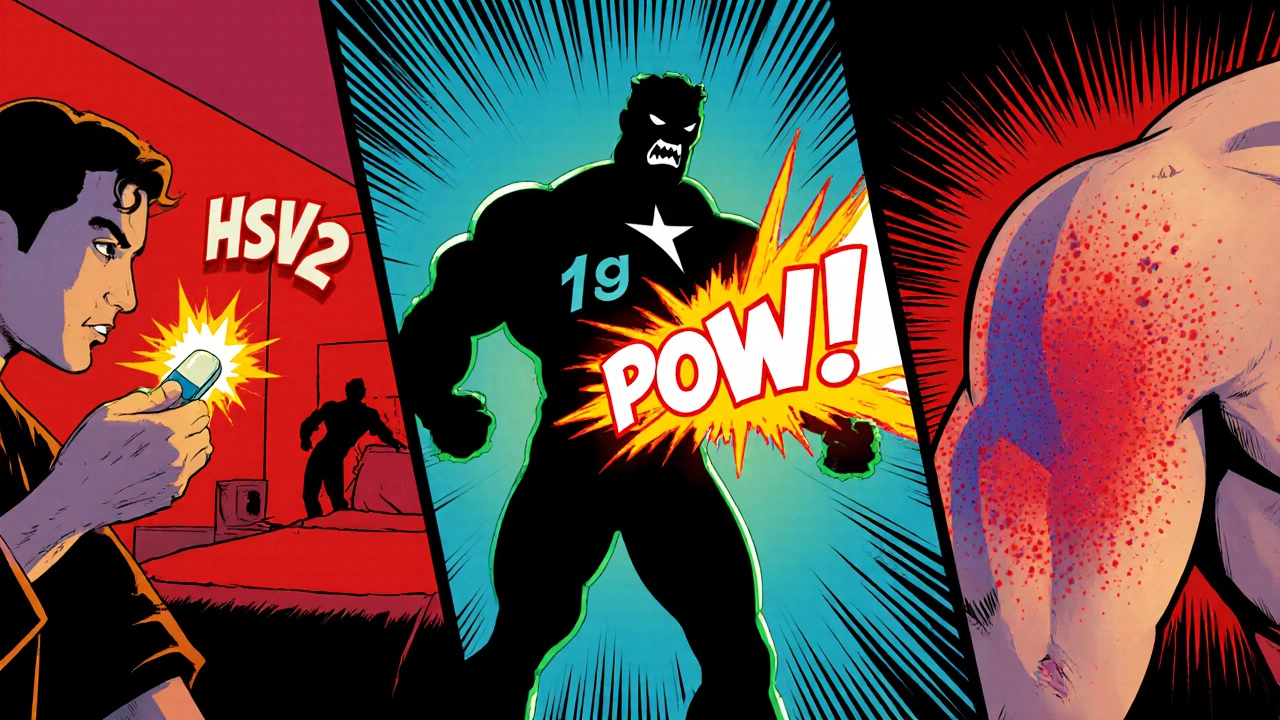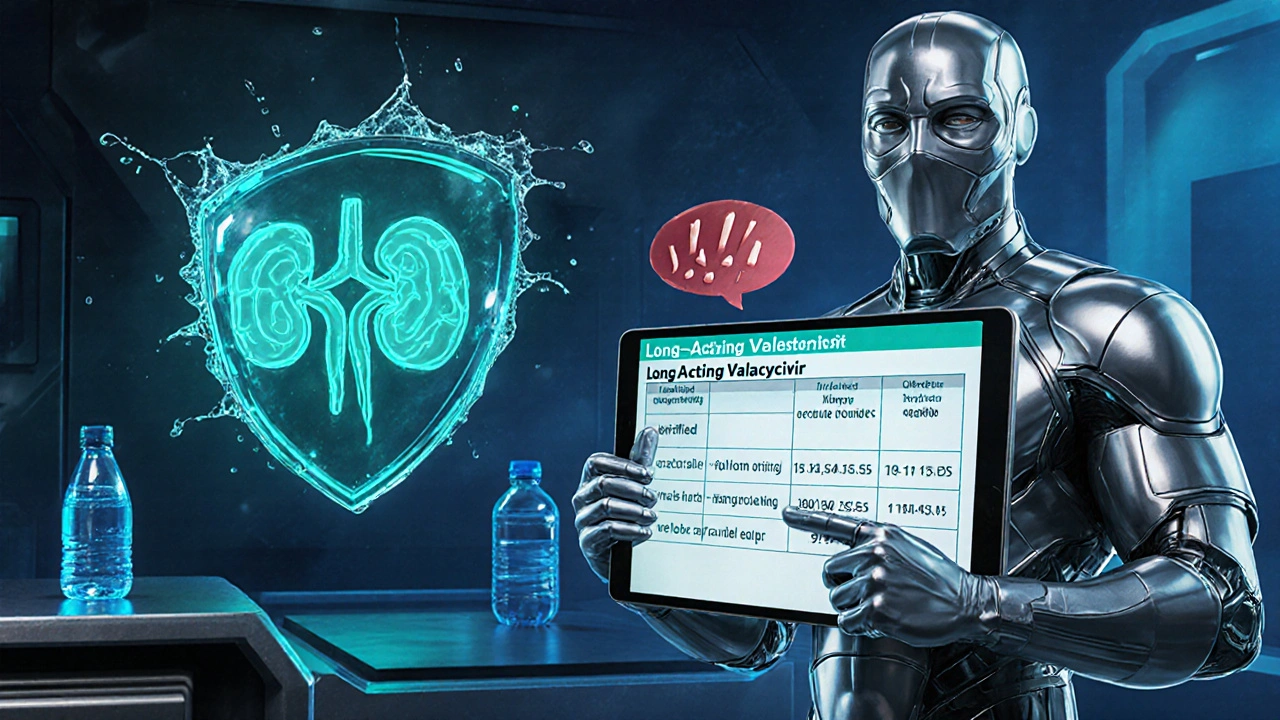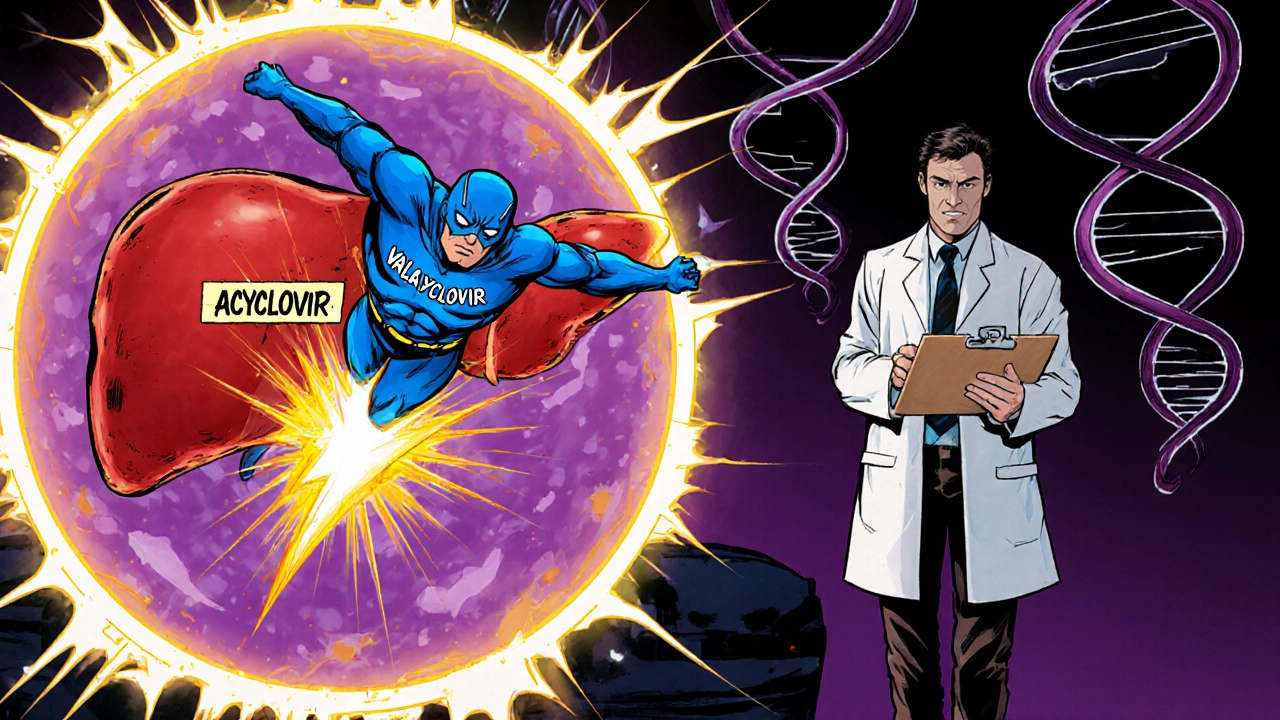Valacyclovir Dosing Calculator
Calculate Your Valacyclovir Dose
Recommended Dose
Disclaimer: This tool provides general dosing guidance based on FDA-approved indications.
Always consult your healthcare provider before adjusting medication.
When you hear the name Valacyclovir is a prodrug of the antiviral acyclovir, you probably think of cold sores or genital herpes. But the drug does a lot more than just quiet those annoying outbreaks. Below we break down the full range of valacyclovir benefits, explore when doctors prescribe it for other infections, compare it with similar antivirals, and give you practical tips on dosing and safety.
Key Takeaways
- Valacyclovir is converted to acyclovir in the body, giving it 3‑4 times higher bio‑availability.
- Besides HSV‑1 and HSV‑2, it’s approved for shingles (VZV) and for preventing cytomegalovirus (CMV) disease in transplant patients.
- Off‑label, it helps suppress recurrent outbreaks, reduce viral shedding, and lower transmission risk.
- It’s generally safe; the main concerns are kidney function, dosing in pregnancy, and drug‑drug interactions.
- When compared with acyclovir or famciclovir, valacyclovir offers simpler dosing and faster symptom relief.
How Valacyclovir Works
Valacyclovir belongs to the class of nucleoside analogues. After oral intake, the liver enzyme valacyclovir hydrolase converts it into acyclovir, which then mimics the building blocks of viral DNA. The viral enzyme DNA polymerase incorporates the analogue, halting DNA chain elongation. This mechanism stops replication of several DNA viruses, most notably Herpes Simplex Virus (HSV‑1, HSV‑2), Varicella‑zoster virus (VZV) and Cytomegalovirus (CMV). Because the drug targets a viral enzyme that human cells lack, it’s highly selective with low toxicity.
Approved Uses: More Than Just Herpes
Regulatory agencies list three primary indications for valacyclovir:
- Genital herpes - initial episodes, recurrent outbreaks, and chronic suppressive therapy.
- Cold sores (herpes labialis) - both treatment of active lesions and prophylaxis before triggers like sun exposure.
- Shingles (herpes zoster) - to shorten rash duration and reduce post‑herpetic neuralgia.
In addition, the drug is approved in the United States for CMV prophylaxis in kidney‑transplant recipients, a niche but high‑risk population.

Off‑Label Benefits That Patients Notice
Doctors often prescribe valacyclovir for reasons that fall outside the label:
- Reducing asymptomatic viral shedding - studies show a 70% drop in HSV‑2 shedding with daily 500mg dosing, lowering transmission odds.
- Preventing recurrent shingles - older adults taking 1g daily after an acute episode reduce the chance of a second attack by about 50%.
- Managing HSV‑related complications - such as HSV encephalitis, where high‑dose IV valacyclovir (converted to acyclovir) achieves therapeutic levels faster.
- Reducing oral ulcer severity in Behçet’s disease - small trials reported faster healing when valacyclovir was added to standard immunosuppressants.
These uses are supported by peer‑reviewed data, even if they haven’t secured formal approval yet.
Dosage Forms, Bio‑Availability, and Practical Dosing
Valacyclovir is sold as 500mg and 1g tablets. Because it’s a prodrug, oral bio‑availability reaches 55‑70%, compared with just 15‑30% for acyclovir. This difference translates into fewer pills and steadier blood levels.
Typical regimens (adult, healthy kidney):
- Genital herpes - initial episode: 1g twice daily for 10days.
- Suppressive therapy: 500mg once daily (or 1g twice daily for frequent outbreaks).
- Cold sores - start 2g at first sign, then 1g 12h later.
- Shingles - 1g three times daily for 7days.
Renal impairment requires dose reduction; the drug is cleared principally by glomerular filtration. For CrCl<50mL/min, the dose is usually cut in half.
Safety Profile and Common Concerns
Overall, valacyclovir is well tolerated. The most frequent side effects (≥5% of users) are headache, nausea, and mild abdominal discomfort. Rare but serious issues include:
- Nephrotoxicity - mainly from crystallization of acyclovir in the renal tubules, mitigated by staying well‑hydrated.
- Neurologic symptoms - such as agitation or seizures, usually in patients with severe renal failure.
- Cutaneous reactions - Stevens‑Johnson syndrome has been reported, though extremely rare.
Pregnancy: Category B (US) - animal studies show no risk, and limited human data suggest it’s safe after the first trimester. Always discuss with a healthcare provider.

Comparing Valacyclovir to Other Antivirals
| Attribute | Valacyclovir | Acyclovir | Famciclovir |
|---|---|---|---|
| Prodrug of | Acyclovir | None (active) | Penciclovir |
| Oral bio‑availability | 55‑70% | 15‑30% | 77% |
| Typical dosing frequency | Once or twice daily | Five times daily | Three times daily |
| Peak plasma level (mg/L) | ≈2.2 (1g dose) | ≈0.5 (400mg dose) | ≈2.8 (250mg dose) |
| Renal dose adjustment | Yes, based on CrCl | Yes, stricter | Yes, similar to valacyclovir |
| Best for | Simple regimens, rapid symptom relief | Cost‑sensitive, inpatient IV conversion | Shingles prophylaxis, pediatric use |
The table shows why many clinicians favor valacyclovir for outpatient herpes care: fewer pills, steadier blood levels, and comparable efficacy.
Practical Tips & Common Pitfalls
- Start early. The sooner you begin (ideally within 24h of lesion onset), the faster the lesion heals and the less viral shedding occurs.
- Hydrate well. Drinking at least 2L of fluid daily helps prevent crystal formation in the kidneys.
- Check kidney function. A simple blood test before the first prescription can avert dose‑related toxicity.
- Mind drug interactions. Valacyclovir can increase serum levels of probenecid and may reduce the efficacy of certain antiretrovirals-always review the medication list.
- Don’t double‑dose for missed pills. If you forget, take the missed dose as soon as you remember, unless it’s close to the next scheduled dose.
Future Directions: What’s on the Horizon?
Researchers are exploring long‑acting valacyclovir implants for chronic suppressive therapy, especially in immunocompromised patients. Early phase‑II trials suggest that a sub‑cutaneous depot could maintain therapeutic levels for up to four weeks, dramatically improving adherence. Additionally, combination therapy with immune‑modulating agents is being studied to see if it can further reduce post‑herpetic neuralgia.
Frequently Asked Questions
Can I use valacyclovir to prevent a partner from getting herpes?
Yes. Daily suppressive therapy (500mg once daily) cuts the risk of transmission by about 50% when the infected partner takes the medication consistently.
Is valacyclovir safe for people with kidney disease?
It’s safe if the dose is reduced according to the glomerular filtration rate. Your doctor will calculate the appropriate adjustment.
How quickly does valacyclovir work for a cold sore?
If started within the first 24hours, most people notice the lesion start to flatten in 1‑2days and heal fully in about a week.
Can I take valacyclovir while pregnant?
The drug is classified as pregnancy Category B. It’s generally considered safe after the first trimester, but you should discuss any antiviral use with your obstetrician.
What should I do if I miss a dose?
Take the missed pill as soon as you remember, unless it’s almost time for the next dose. In that case, skip the missed one and continue with your regular schedule.

Sheila Hood
August 8, 2025
Valacyclovir’s 3‑4× higher bio‑availability means you’re not stuck popping a dozen acyclovir tablets each day – unless you’ve decided pills are a new hobby.
Melissa Jansson
August 8, 2025
While you’re waxing lyrical about pill counts, let’s not forget the pharmacokinetic symphony: valacyclovir, a prodrug, undergoes hepatic hydrolysis via valacyclovir hydrolase, achieving peak plasma concentrations in 1‑2 hours, thereby outpacing its parent analogue in both Cmax and AUC – a veritable tour de force for clinicians craving therapeutic certainty.
Max Rogers
August 9, 2025
For anyone tweaking doses, remember to adjust for creatinine clearance; the standard rule‑of‑thumb is to halve the dose when eGFR drops below 50 mL/min, and to further reduce frequency if it falls under 25 mL/min. This keeps the drug in the therapeutic window without overburdening the kidneys.
Louie Hadley
August 9, 2025
It’s also worth noting that the off‑label uses, like daily suppressive therapy to curb asymptomatic shedding, have solid data behind them. Reducing viral shedding not only protects partners but also diminishes the chance of developing resistant strains.
Ginny Gladish
August 9, 2025
From a critical standpoint, the literature on valacyclovir for Behçet’s disease remains sparse; the handful of small‑scale trials do not justify routine prescription outside of a research protocol. Moreover, the cost differential versus generic acyclovir can be prohibitive for many patients, especially when insurance coverage is limited.
Faye Bormann
August 9, 2025
Okay, let’s dive deep into why valacyclovir is more than just a “cold sore pill”. First, the drug’s prodrug nature gives it a bio‑availability that’s roughly three‑to‑four times that of acyclovir, which translates into fewer tablets and steadier plasma levels. Second, because it’s converted in the liver, the dosing schedule becomes less burdensome – a huge quality‑of‑life improvement for patients with recurring outbreaks. Third, the renal adjustment algorithm is straightforward: you either halve or quarter the dose depending on eGFR thresholds, and you don’t need to reinvent the wheel every time you see a new lab result. Fourth, while the FDA only lists three primary indications, clinicians have amassed a respectable body of evidence supporting its use for suppressing HSV‑2 shedding, lowering transmission risk, and even preventing secondary shingles in older adults. Fifth, the side‑effect profile remains mild; most adverse events are limited to transient headache or nausea, and serious nephrotoxicity is rare when dosing guidelines are followed. Sixth, there’s a growing interest in using high‑dose IV valacyclovir for HSV encephalitis, where rapid viral suppression can be lifesaving. Seventh, in transplant medicine, valacyclovir’s role in CMV prophylaxis is indispensable, sparing patients from more toxic agents. Eighth, the drug’s interactions are manageable – avoid concomitant nephrotoxic NSAIDs, and you’re good. Ninth, patient adherence shoots up when the regimen is once‑daily rather than multiple times a day, which is exactly what the 500 mg suppressive dose offers. Tenth, pharmacies often stock the 500 mg and 1 g tablets, so dose flexibility is a non‑issue. Eleventh, the drug’s cost, while higher than generic acyclovir, is offset by the reduced pill burden and fewer clinic visits. Twelfth, the pharmacodynamics ensure that viral DNA polymerase is effectively inhibited, halting replication at an early stage. Thirteenth, resistance remains uncommon, especially when patients stick to the prescribed regimen. Fourteenth, the drug’s safety in pregnancy has been documented, making it a viable option for expectant mothers suffering from severe HSV outbreaks. Finally, the patient education component – teaching when to start therapy at the first sign of a prodrome – maximizes efficacy and keeps outbreaks short. All in all, valacyclovir is a versatile tool that deserves a spot in every clinician’s antiviral armamentarium.
Kathy Butterfield
August 9, 2025
Great summary! 👍💊
Zane Nelson
August 9, 2025
While the preceding remarks are undeniably thorough, one must question whether the enthusiasm for off‑label expansion is not merely a reflection of pharmaceutical optimism. A measured appraisal would demand larger, double‑blind trials before bestowing such broad credence upon ancillary indications.
Sahithi Bhasyam
August 9, 2025
i totally get u!! valacyclovir is awesomes!!! but pls be careful . 🙏🏽 its not a magic bullet & you still need to watch your kidneys!!!
mike putty
August 9, 2025
Remember, staying on top of dosing schedules and checking kidney function regularly can keep the treatment safe and effective for the long haul.
Kayla Reeves
August 9, 2025
It is morally dubious to prescribe expensive antivirals without clear evidence, especially when cheaper alternatives exist.
Abhinanda Mallick
August 9, 2025
From a national health perspective, expanding access to valacyclovir aligns with our commitment to curb viral disease burdens, yet we must avoid the pitfall of overprescribing without stringent guidelines – a balance that preserves both public health and fiscal responsibility.
Richard Wieland
August 9, 2025
In essence, the drug’s utility hinges on judicious use; when applied thoughtfully, it exemplifies the harmony between pharmacology and patient wellbeing.